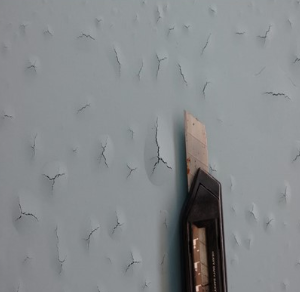In a few cases severe blistering of thin synthetic resin floorings occurs between 3 months and two years after laying. These blisters commonly vary in size from a few mm in diameter up to 100 mm, with heights up to 15 mm. When drilled into or otherwise broken the blisters are found to contain an aqueous liquid under very high pressure. The mechanism of their formation is not fully understood but it is assumed because of their physical state that they are caused by a process of osmosis. Blistering which occurs soon after the flooring is installed is unlikely to be caused by osmosis and is more likely to result from water contained in the structure.
Osmotic blisters only occur with thinner synthetic resin floorings, resin coatings and flow applied systems, up to about 6 mm in thickness. The problem has not been observed with trowel applied resin floorings probably because of their higher resistance to deformation and greater lateral permeability.
..............................Please refer to FeRFA Guidance Note No 2: Osmosis in Resin Flooring ISBN 0 9538020 5 1
Because the mechanism is not fully understood it is not possible to be specific about the steps which should be taken to avoid osmotic blistering. However it is considered good practice to take the following steps in order to minimise the risk.
a) In new construction ensure the base concrete has low soluble salts by avoiding poorly washed aggregates and by curing the concrete well immediately after laying to prevent premature surface drying out;
b) Allow the concrete to dry out thoroughly after curing, preferably for a minimum of 21 days.
c) By the use of mechanical rather than chemical means of preparing the concrete surface. In particular by avoiding the use of acid etching;
d) By avoiding washing the concrete surface with detergent solutions as part of the preparation procedure.
e) By the complete removal of all contamination from existing floors: this may prove very difficult where the concrete has been saturated for long periods with water soluble materials.
f) Any levelling screeds should preferably be polymer-modified to minimise permeability and salt migration.
g) By the use of water vapour permeable floorings.
h) By the use of solvent-free primers rather than water-borne systems, under impervious resin floorings.
j) By ensuring that the synthetic resin flooring is precisely proportioned, either by weight or volume as specified by the product manufacturer.
Where osmosis has occurred, techniques which have proved successful in preventing the problem reappearing, after cutting out the affected area and mechanically cleaning the exposed concrete, include:
a) Double application of a penetrating primer to the base to ensure complete coverage and
maximum adhesion of the replaced flooring.
b) Replacing with a trowel applied flooring at a thickness of at least 6 mm;
c) Hot compressed air blasting of the exposed concrete coupled with the application of a
penetrating primer whilst the concrete is still warm.
d) By the use of water vapour permeable floorings.
Many thanks to Google.com, FeRFA, Doc88.com from where the details were taken.



No comments:
Post a Comment